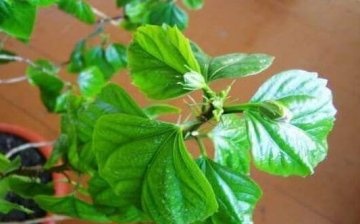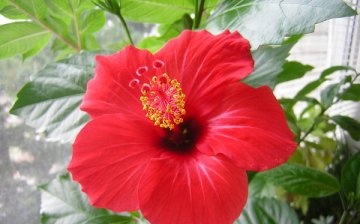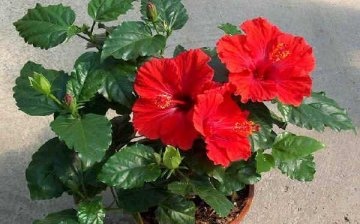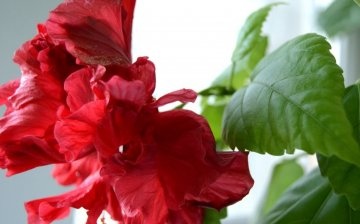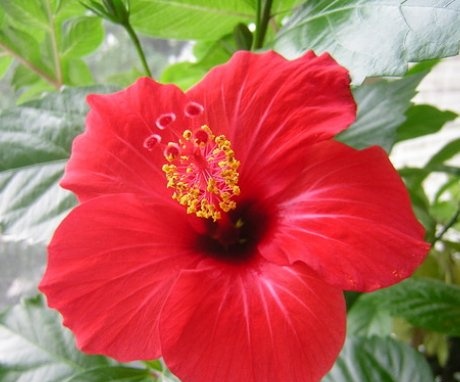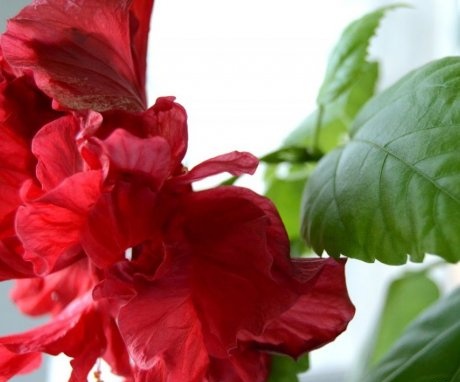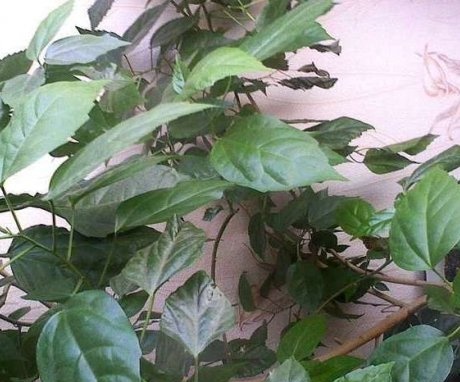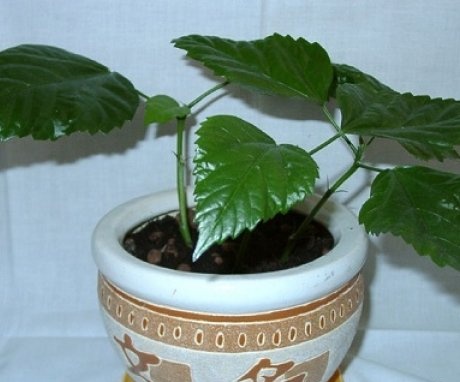Why won't the Chinese rose bloom and shed its leaves?
Chinese rose, as the Chinese hibiscus is called, a common houseplant. It grows wild in Southeast Asia and the Pacific Islands. Belongs to the Malvaceae family.
Content:
- Chinese rose: description
- Conditions for growing a Chinese rose
- Reasons for dropping buds and leaves
- Why the Chinese rose doesn't bloom
- Reproduction and care features
Chinese rose: description
In natural conditions hibiscus Is a perennial evergreen, most commonly a bush, but can form and grow as a tree. Their main value is large beautiful flowers. They are used for decoration, some types are used to make hibiscus tea. The seeds of the plant are used to make drinks pink. There are herbaceous species in which the stems disappear after flowering and reappear in the spring. Nowadays, outdoor-grown hibiscus (Syrian) are making their way further north, encircling new territories. They are said to be able to withstand frosts up to 20 degrees. But in reality, hibiscus often freeze slightly in winter, so they require shelter.
The Chinese rose or Chinese rose is grown indoors.
If possible, for the summer, the plant is taken out into the garden. Indoors, it can reach a height of three meters. But usually the height of the rooms does not allow you to grow so high. Therefore, it is limited by forming a bush of a certain shape. There are specially created varieties of low hibiscus. They can be grown even in a small room. The bush of the Chinese rose is spreading. The leaves are shiny, serrated, most often dark green. Rosa Cooperi has especially beautiful leaves with pink flowers. They are covered with light or red spots and streaks. The size of the flower of the Chinese rose, from 9 to 16 cm. The flowers are cup-shaped, often double. The colors are red, pink, purple, yellow, orange, white. Most varieties have no scent flowers, but there are varieties with a pleasant scent.
Flowers appear in the middle of summer. Each of them blooms for only one day. The flower opens early in the morning, and fades in the evening. At the same time, with proper care, up to 50 flowers can bloom on one bush. But for this, the plant must be large. Due to the fact that a lot of buds are formed, the Chinese rose pleases the owners with abundant flowering for 2-3 months. Usually in September the flowering period ends and the plant retires.
Conditions for growing a Chinese rose
The Chinese rose, like any tropical plant, loves sunlight. You should not place it in the sun, it is better to shade it from the midday sun. This is usually easy to do, as the Chinese rose pot still does not fit on the window and is placed in the middle of the room.
The Chinese rose loves abundant watering, especially in spring and summer.
In winter, it is watered less, but the soil in the pot should not dry out. Watering is reduced along with a decrease in room temperature. The rose responds well to spraying. The leaves become fresh and shiny. Room temperature where it rises Chinese rose, should not fall below 12 ° C. The air should not be too dry.If the radiators dry it out too much, you need to spray the plant with a spray bottle more often.
Plant transplant:
- The young plant is transplanted every year, gradually increasing the size of the pot. After it reaches the age of five, it can be transplanted every 3-4 years.
- The indication for transplanting is that the roots entwine the entire clod of earth and crawl out into the holes in the pot.
- The soil for transplanting is prepared by mixing 2 parts of sod land, part of leaf and humus. Add a few handfuls of sand. Moisten a clod of earth with roots entwining it, carefully remove it from the pot.
- Some of the old roots are cut off. This will encourage the growth of new branches, which will then form flower buds.
The state of dormancy in the life of a plant lasts from November to February. The room temperature should be between 14 and 16 degrees. After all, flower buds are laid at 15 ° C. By sending the Chinese rose to rest, some gardeners are encouraging leaf shedding. To do this, gradually reduce watering, lowering the temperature. After the leaves fall off, the branches are cut off, leaving 8 cm each. They are sent to a cool room, where the plant will stay until February.
In mid-February, the plant is brought into a warm room, watering begins and fertilizers of low concentration are applied. Use organic and mineral fertilizersalternating them. Top dressing is carried out 2 times a month. Before and after fertilization, the plant is watered. Break the crust after each watering so that air can easily pass to the roots. You can create such conditions for the Chinese rose so that it does not shed its leaves, but flower buds still form and the rose blooms. Simply lower the room temperature and reduce watering.
Reasons for dropping buds and leaves
It may seem that the Chinese rose is a low maintenance plant. But in fact, this is a rather capricious flower. If the usual conditions are violated, the Chinese rose reacts by dropping flowers, buds and even leaves:
- The flower reacts especially violently to a sharp change in temperature. If a Chinese rose, which was in the garden in summer, is brought into the house after a strong drop in temperature, it will shed all its leaves in a couple of days. But do not throw the bare trunk out of the pot. The branches are pruned and the plant is sent to rest. Watering so that the clod of earth does not dry out. Then, closer to spring, they increase watering and raise the temperature.
- The flower also throws off its leaves when it stands in a draft.
- In summer, the Chinese rose sheds its leaves if it is watered too abundantly. In this case, the amount of moisture is reduced to dry the soil.
- The Chinese rose does not like changing illumination. If the plant pot is turned frequently, it can shed the buds.
- If the air in the room is too dry, the buds fall off. It is necessary to spray the leaves with a spray bottle every day.
- Chinese rose can shed leaves and buds if used too much when caring for it. fertilizers... It is necessary to reduce the dose of fertilizers or stop applying them altogether.
With insufficient fertilization, plants may look thin and naked. Fertilizers in this case are administered once a week. But the concentration is reduced by 2 times.
Why doesn't the Chinese rose bloom?
Sometimes the Chinese rose does not shed its leaves, and the buds do not appear at all or very few of them are formed. What is the reason:
- This could be because the plant did not have a dormant period. Most often this happens if the temperature in the apartment is constantly at the same level. In this case, there is no way for the plant to provide the desired drop to 15 degrees, and the buds are not laid.
- The Chinese rose does not bloom if its branches are not cut. After all, flowers appear on young shoots. If you did not do this before the rest period, you need to carry out the operation after coming out of it.
- The Chinese rose does not bloom even if the plant is abundantly fed with nitrogen fertilizers. To remedy the situation, they stop applying nitrogen, switching to potash and phosphorus fertilizers.
- If the flower is installed so that hot sunlight falls on it, burns may appear on the leaves. They appear as whitish spots. So that the leaves are restored, and x every day they are wiped with a solution of sugar in the same proportion as for feeding the rose. The leaves absorb the sugar and become fresh and shiny.
- If the plant is settled pests and their number is quite large, the plant may not bloom. Pests can be aphid or a spider mite. They are treated with insecticides, having previously isolated from other plants.
- Rusty spots on the leaves can appear when the plant is affected by Alternaria fungi. This happens when the plant is not getting enough nutrients. They are treated with Zineb fungicides. Foliar dressing is carried out. The same treatment when black spots appear on the leaves.
If the leaves and flowers wither, curl, the flowers turn pale, or the stems turn black, the plant is not cured, but destroyed.
Reproduction and care features
Chinese rose multiplies seeds and cuttings. Propagated by seeds for a long time, moreover, maternal properties are not always preserved with this method of reproduction.
Easier to use for growing Chinese rose cuttings.
They are cut in the middle of summer from annual shoots. The stalk must have a couple of internodes. Root it in a mini-greenhouse with bottom heating or, even easier, install it in a pot and cover it with a glass jar. After a month, the cuttings begin to grow upward. This suggests that the roots of the young plant have formed. It can be transplanted into a pot with a diameter of up to 9 cm. Water the Chinese rose with warm water.
Usually, a young rose grows from the cuttings in a year, which forms buds and blooms. The tree often grows too tall over the years. To make it more compact, pinch the top.
Top dressing for a Chinese rose can be quite unexpected:
- You can pour sugar syrup on it. To do this, dilute half a teaspoon of sugar in a glass of water.
- A water solution obtained from animal blood will be useful for the Chinese rose. It is usually obtained by defrosting meat.
Some growers would like the Chinese rose hibiscus to bloom not in summer, when there are already plenty of flowers around, but in winter. This can be done in two ways:
- Illuminate in autumn and winter phytolamps or a fluorescent lamp.
- The flowering period is deliberately delayed. For this, transplanting and pruning held not in early spring, but in May. Before that, it is watered a little, kept in a cool room. After pruning, young branches will begin to grow. They need to be pruned again in July. In this case, flower buds will begin to form in September.
More information can be found in the video:



